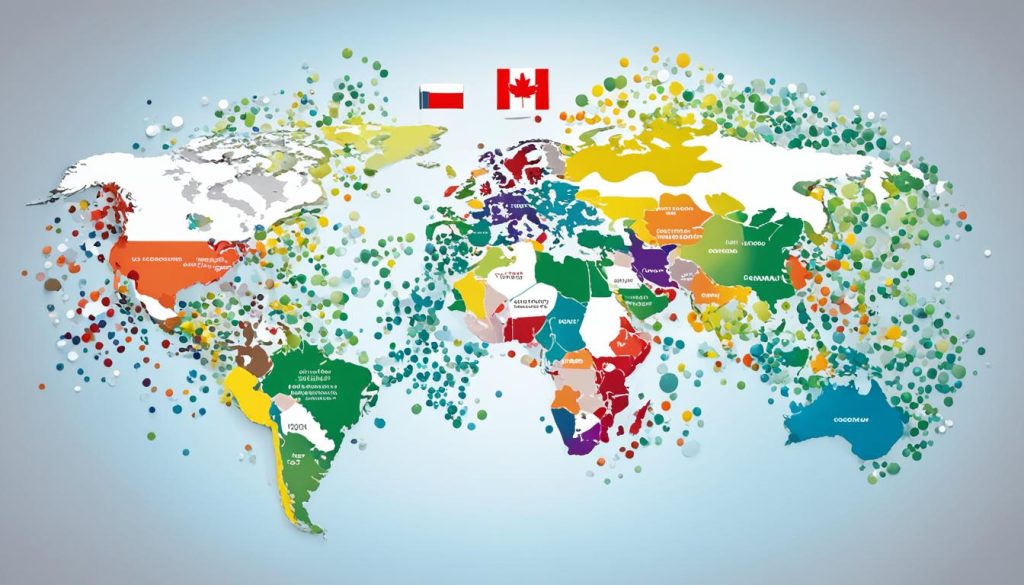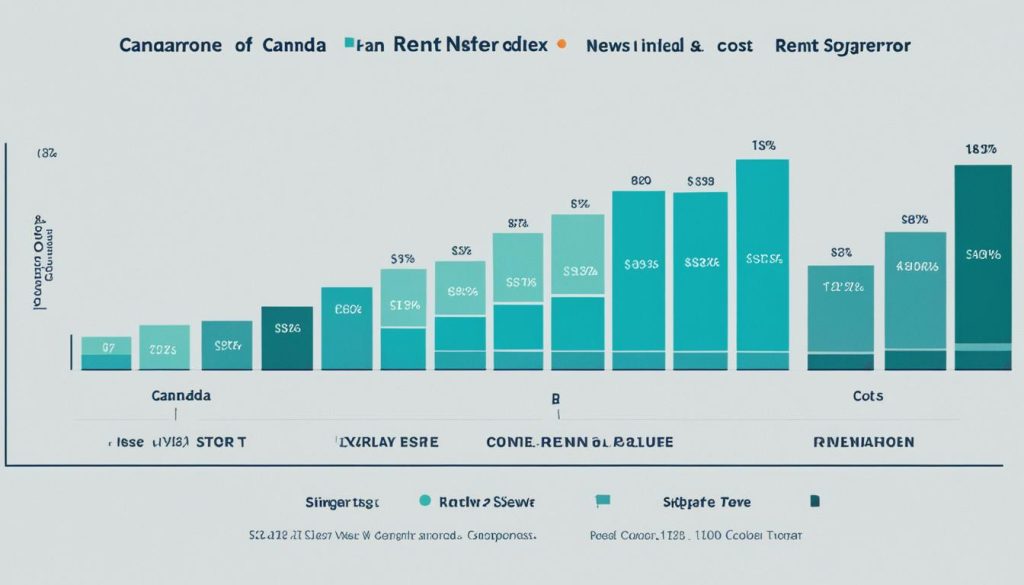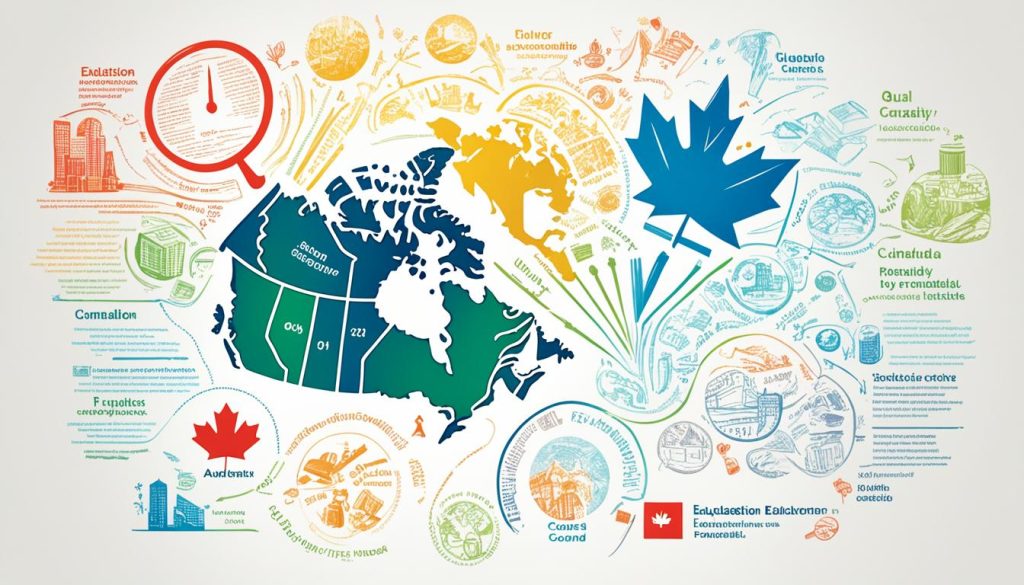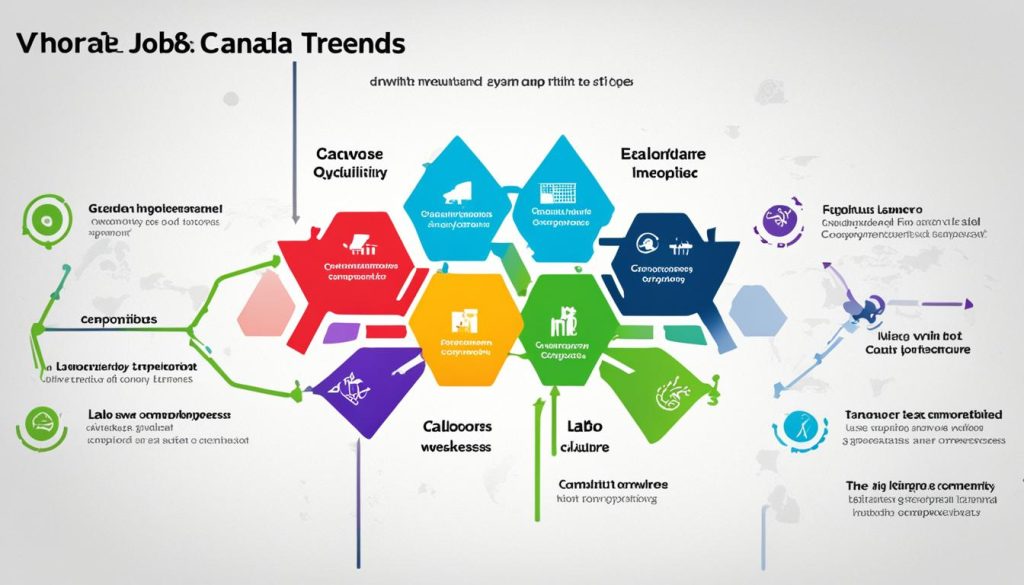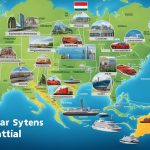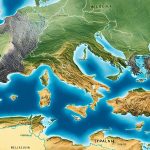Thinking about where to live? It’s key to compare Canada, Singapore, and New Zealand. These countries have lively economies and top-notch living. They offer a great look at what makes life good in different places.
They each shine in areas like health, education, and overall happiness. It’s smart to look at the cost of living and well-being in these favourite spots.
If you’re considering a move or just curious, this comparison helps. It shows the differences between Canada’s wide-open spaces, Singapore’s bustling economy, and New Zealand’s stunning nature. Understanding these factors can help in making a wise choice.
Introduction to Comparing Economies and Living Standards
When discussing relocating around the world, understanding economic standards is key. We compare the living conditions of Canada, Singapore, and New Zealand. This gives us important insights for international comparison. We look into economic indicators, check GDP per capita, and review living costs. Plus, we consider how the culture and social aspects make these countries appealing or not.
This overview helps those making financial plans or thinking about relocation considerations.
- Analysing the GDP per capita to gauge economic health and individual prosperity.
- Scrutinising living expenses and their impact on day-to-day financial requirements.
- Exploring the social dimensions that influence inhabitants’ satisfaction and contentment.
Every country offers a mix of opportunities and hurdles. It affects both your wallet and life quality. Picking where to live is about finding a balance. It’s choosing between financial sense and the quest for happiness. The aim of this analysis is to arm people with the facts. So, they can make wise choices when picking a new place to call home.
Overview of Canada’s Economy and Quality of Living
Canada anchors the North American continent with economic strength from natural resources and tech innovation. These factors create a stable GDP growth rate tied to economic stability. The nation’s economy thrives due to its industries and global market position.
Economic Indicators and GDP Growth
Economic health in Canada is seen through key indicators, showing steady GDP growth. This growth supports social welfare and public health, making the economy stable.
Key Sectors Driving the Canadian Economy
Canada’s economy is boosted by key industries such as resource extraction and technology. These sectors create jobs and sustain economic growth.
Standard of Living Metrics
Canada’s living standards are high thanks to social programs and good income levels. Services like healthcare to housing impact Canadians’ daily lives.
Healthcare and Education
Canada’s healthcare system is known for being universal and accessible. Education is also valued, focusing on spreading knowledge to future generations.
This economic environment gives Canadians a quality of life that is both enviable and exemplary. It sets a standard for societal prosperity and well-being.
Analyzing Singapore’s Economic Dynamism and Life Quality
Singapore has grown to be a global financial centre. This is thanks to its vibrant economy and visionary leadership. The nation’s economy is strong, with a thriving financial sector that attracts global investors. Singapore uses its key location to boost its market and engage in global trade, making it essential in world commerce.
The excellent quality of life in Singapore connects to its economic success. As a financial hub, it offers high living standards. But, there’s more to life here than wealth. The country boasts top-notch public services. This includes great public transport and connectivity. These make living in Singapore both enjoyable and easy.
- Advanced Healthcare System: Singapore’s healthcare is among the world’s best. This greatly improves life satisfaction.
- Affordable Living Expenses: Despite its reputation, economic strategies help balance living costs with its prosperous economy.
- Public Safety and Cleanliness: The government’s efforts ensure safety and cleanliness, crucial for the nation’s high life quality.
Singapore’s economic growth aims to improve citizens’ and residents’ lives. It mixes economic strategies with social policies to enhance life quality. This serves as a model for other countries. The country shows how economic and lifestyle qualities can blend for a comprehensive living experience.
Understanding New Zealand’s Economic Landscape and Living Conditions
New Zealand’s economy is a mix of farming, tech, and tourism, making up a vibrant scene. It’s known for being stable and growing, thanks to industries like dairy and film. This ensures a high quality of life for its people, showing in their well-being.
Economic Structure and Major Industries
New Zealand’s economy is boosted by key sectors, especially dairy which leads in exports and GDP. It also has strong film, tourism, and tech sectors. These industries provide great chances for those living in or moving to New Zealand.
Characteristics of New Zealand’s Quality of Life
Life in New Zealand means high well-being, with top healthcare, education, and infrastructure. It’s known worldwide for its living conditions. This focus on quality living allows New Zealanders to enjoy high standards in a beautiful setting.
Environmental Aspects and Its Influence
New Zealand’s identity is closely tied to its natural setting. It takes care to safeguard its green spaces and biodiversity. New Zealanders love the outdoors and eco-friendly living. This shows a deep connection with nature.
To sum up, New Zealand’s robust economy, key sectors, and stunning nature ensure a top life quality. Its efforts to protect the environment while growing economically offer a fulfilling life. This attracts people not just for the views but for a well-rounded, successful life.
Cost of Living Comparison: Canada vs. Singapore vs. New Zealand
Thinking about moving abroad? It’s crucial to know the cost of living first. This section looks closely at expenses for housing, food, and overall spending in Canada, Singapore, and New Zealand.
Housing and Rent Index Insights
The cost of homes varies greatly between these three countries. Canada’s housing prices are average, but cities like Vancouver and Toronto are more expensive. Singapore faces high costs due to its small size and economic status. New Zealand has become popular, causing prices to rise.
Knowing about the housing market in these places can help you estimate your living costs there.
Expenses on Groceries and Dining Out
Food prices differ from one country to another. Singapore spends more on food because it imports a lot. New Zealand’s local produce keeps its food costs down. Canada offers a variety of both local and imported goods.
For eating out, Singapore has wallet-friendly hawker centres and fancy restaurants. Canada and New Zealand provide dining choices for different budgets.
Local Purchasing Power Analysis
Purchasing power shows how much people can buy with their money. Canada offers a good balance between earnings and costs. Singapore has high costs but high salaries too. New Zealand’s affordable living and good salaries make it appealing.
This means people in these countries enjoy a level of financial freedom, depending on their income and living expenses.
Assessing Real Estate Markets in Canada, Singapore, and New Zealand
The health of the housing market reflects an economy’s well-being. Variations in real estate trends show smart paths for property investment. Canada, Singapore, and New Zealand’s housing market assessment reveals both opportunities and challenges for buyers and renters.
In Canada, the real estate scene is competitive. Property values are soaring, especially in places like Toronto and Vancouver. Singapore’s approach to housing involves innovative policies for its dense population. In contrast, New Zealand’s beauty drives the demand for properties with stunning views.
- Current Real Estate Trends
- Canada faces high demand and low supply, causing prices to rise.
- Singapore’s market is becoming stable, thanks to government efforts to control it.
- New Zealand shows different markets, with Auckland’s prices soaring.
- Opportunities in Property Investment
- Canada sees growth in suburban markets due to the rise of remote work.
- Singapore’s luxury condos attract investors worldwide, offering stability and quality.
- New Zealand’s eco-friendly homes gain interest for their sustainability.
- Housing Market Assessment Considerations
- Looking at how economic policies affect housing affordability long-term.
- Assessing immigration and population growth’s impact on housing demand.
- Understanding interest rates and lending criteria’s influence on purchasing.
To keep up with changes, it’s vital to stay informed about real estate trends. Before making property investments, a thorough housing market assessment is essential. This way, one can understand each market’s opportunities and pitfalls.
Educational Systems and Opportunities
Putting money into education is key for a bright future. How much a country spends on education affects its progress. Places like Canada, Singapore, and New Zealand show how spending changes student lives and education’s value.
Investing in Education: Expenditures and Outcomes
Looking at how much of their GDP countries spend on education shows commitment. They spend on resources, facilities, and grants, showing that investing in education is a priority. This investment improves education quality and helps students face global challenges.
School Life Expectancy
The time students spend in school shapes their futures. Long school times boost skills and help build a strong workforce. Longer education leads to a richer country, with a smarter society.
International University Rankings and Reputation
Good university rankings attract students worldwide. These rankings show academic quality and student life. In Canada, Singapore, and New Zealand, top universities draw international talents, showing the value of investing in education.
- Public Education Funding: Reflecting on the educational resource allocation compared to GDP.
- Educational Quality: Measuring the resultant scholastic achievements and learning environments.
- Academic Investment: Investigating infrastructure and programme investments.
- Student Life Expectancy: Considering how long students engage with the education system.
- Educational Careers: Opportunities and outcomes derived from educational experiences.
- Schooling Duration: The expected time-frame for students to complete their education.
- University Rankings: Assessing the global standing and reputation of tertiary institutions.
- Higher Education Prestige: The esteem and recognition afforded to institutions for their contributions to academia.
- Global Recognition: Evaluating international perceptions and acknowledgements of educational institutions.
Canada, Singapore, and New Zealand work hard to offer good education. They are open about their spending, believe in the power of education, and value university prestige and global recognition.
Healthcare Services: Accessibility and Quality
Looking at healthcare, we often compare its accessibility and the balance between public and private care. These factors are key to understanding how long people live and how healthy they are. Healthcare in Canada, Singapore, and New Zealand shows us how different methods can affect people’s health.
Comparing Public and Private Healthcare Models
Canada, Singapore, and New Zealand show us the range of healthcare systems. Canada has a healthcare system funded by the public, known for including everyone. Singapore combines public and private healthcare, aiming for efficiency and access. New Zealand’s system is all about public health, focusing on making sure everyone has access to the care they need.
Hospital Beds and Health Infrastructure
Hospital beds per 1,000 people tell us a lot about a country’s healthcare strength. Canada and New Zealand have good healthcare facilities and are always trying to get better. Singapore is known for its excellent healthcare system, thanks to smart investments and the use of technology.
Life Expectancy and Wellness Indicators
The success of a healthcare system is shown in how long its people live and their health levels. High life expectancy and good health outcomes show effective healthcare. Canada, Singapore, and New Zealand invest in healthcare and wellness to keep improving these outcomes.
Employment and Job Market Evaluation
The health of an economy is often shown through its job market trends. These trends tell us if jobs are increasing or decreasing. They point out which jobs are in demand and which are not, due to global changes.
In Canada, the job market is strong, especially in tech and services. Despite the world’s ups and downs, Canada has kept job opportunities steady. This shows how well Canada can handle economic changes.
Singapore’s job market is unique, with finance and logistics leading. It keeps an environment that helps economic activities grow. This growth then creates more jobs.
Looking at New Zealand, we see a job market led by tourism and agriculture. These sectors offer constant job chances. This is especially true in areas where these industries are key to the local economy.
- Understanding the regulatory environment and its impact on job creation.
- Analyzing the level of government support for innovation and entrepreneurship.
- Assessing the flexibility of the job market, considering part-time, remote, and freelance work options.
- Monitoring unemployment rates and their correlation with economic cycles.
These countries show how they adapt to global job trends. Even though their economies are different, the link between job chances and economic policies is clear.
Climate and Environmental Factors Affecting Lifestyle
When looking at moving to Canada, Singapore, or New Zealand, it’s key to understand the climate and environment. These places have their own weather patterns and seasons that affect how people live. Getting to know these can make it easier to live in a way that’s good for the planet.
Weather Patterns and Seasonal Variations
In Canada, you’ll find big changes in the weather with cold winters and warm summers, especially in areas away from the coast. These changes mean people switch up their clothes and activities, from winter sports to summer festivals. This lifestyle changes with the seasons. Singapore has a tropical climate that’s warm and humid all year, which makes picking clothes simpler but means buildings and roads need to handle the heat and rain. New Zealand has a mild winter and a warm summer, making it great for being outdoors.
Geographical Diversity and Natural Amenities
Each country’s landscape affects how you can live there. Canada has mountains, forests, lakes, and rivers, perfect for an active life close to nature. Singapore, although lacking in natural landscapes, has parks and green spaces enjoyed within the city. New Zealand’s stunning nature is part of its national identity, promoting an eco-conscious lifestyle.
When thinking about moving or long visits, it’s often the climate and environment that influence the decision. A place’s natural offerings can improve life quality by offering ways to relax and be active, all while being kind to the environment.
Population Dynamics and Cultural Diversity
When we explore urban areas, we notice how people live closely impacts city layouts and community trends. Countries like Canada, Singapore, and New Zealand manage their cities in ways that welcome cultural diversity. They use smart planning to ensure everyone fits into the community.
Population Density and Urban Planning
City planning and dense populations create challenges and chances for cities. Canada has busy cities and quiet countryside areas. Singapore uses creative designs to fit more people in less space. New Zealand has a spacious setup but still focuses on including everyone.
- Canada’s vastness allows for differing urban density from coast to coast, presenting challenges in connecting diverse communities.
- Singapore’s constrained space leads to pioneering high-density solutions while maintaining quality of life.
- New Zealand’s lower urban density offers a different approach to infrastructure, maintaining spaciousness without sacrificing cultural inclusion.
Multiculturalism and Social Integration
These countries are made up of people from various backgrounds. They don’t just accept differences; they celebrate them. This creates welcoming communities. Events, community programs, and schools in Canada, Singapore, and New Zealand help blend cultures together. They make sure everyone feels part of society.
- Initiatives promoting social cohesion are at the forefront of integrating immigrant communities within Canada’s vast cultural panorama.
- Singapore’s meritocratic ethos and celebration of cultural diversity are pivotal in weaving a harmonious social tapestry.
- New Zealand’s bicultural foundation, coupled with its embracement of new residents, serves as a testament to its dedication to social integrity and unity.
Compare Economy and quality of living between Canada, Singapore and New Zealand
People want to understand what makes a society thrive. They look at economic freedoms, business climates, and how easy it is to start a business in Canada, Singapore, and New Zealand. They also consider income differences and cost of living. Plus, they think about purchasing power. All these factors are mixed with societal happiness and views on corruption. This mix gives us a fuller picture of life in these countries.
Economic Freedom and Entrepreneurship
Economic freedoms play a big role in a country’s business health. Canada’s laws support new ideas. In contrast, Singapore’s rules make it easy for startups and investors. New Zealand focuses on markets and support for small businesses. These approaches show each country’s unique place in world business. They affect how businesses grow.
Income Inequality and Cost of Living Adjustments
Economic growth doesn’t tell the whole story. Income differences show us another side. Making the cost of living fair helps share wealth more evenly. Canada works to lessen these differences with specific policies. Singapore deals with high living costs by helping its people. New Zealand uses purchasing power to make life fairer for everyone, regardless of their income.
Surveying Happiness and Corruption Perceptions
How happy people feel goes beyond just money. It’s about their life quality. Combining this with how they view corruption tells us about their happiness with the government. Canada’s good social programs lead to happiness. Singapore’s efficient rule shows in its low corruption. New Zealand’s openness makes its people happy. This pattern suggests trust and well-being are key to a country’s success.
Conclusion
This detailed study aimed to give readers a wide understanding. It helps in making the tough choice of living in Canada, Singapore, or New Zealand. Each country has its own special qualities. These include stable economies, good social services, beautiful environments, and lively cultures. Together, they influence how desirable and livable a country is.
For anyone thinking about where to live, this article is a basic guide. It looks at various factors like cost of living, healthcare, education, and job opportunities. It offers a clear view not only of each nation’s economic health but also of daily life for their citizens.
In wrapping up our exploration of these diverse lands of opportunity, a crucial point emerges. Choosing where to live involves balancing what matters most to you. Whether it’s the economy, public services, or natural beauty, each nation discussed makes a strong case. In the end, the decision is personal, based on what you value most. Our findings on the economies and living standards in Canada, Singapore, and New Zealand help inform that choice.


